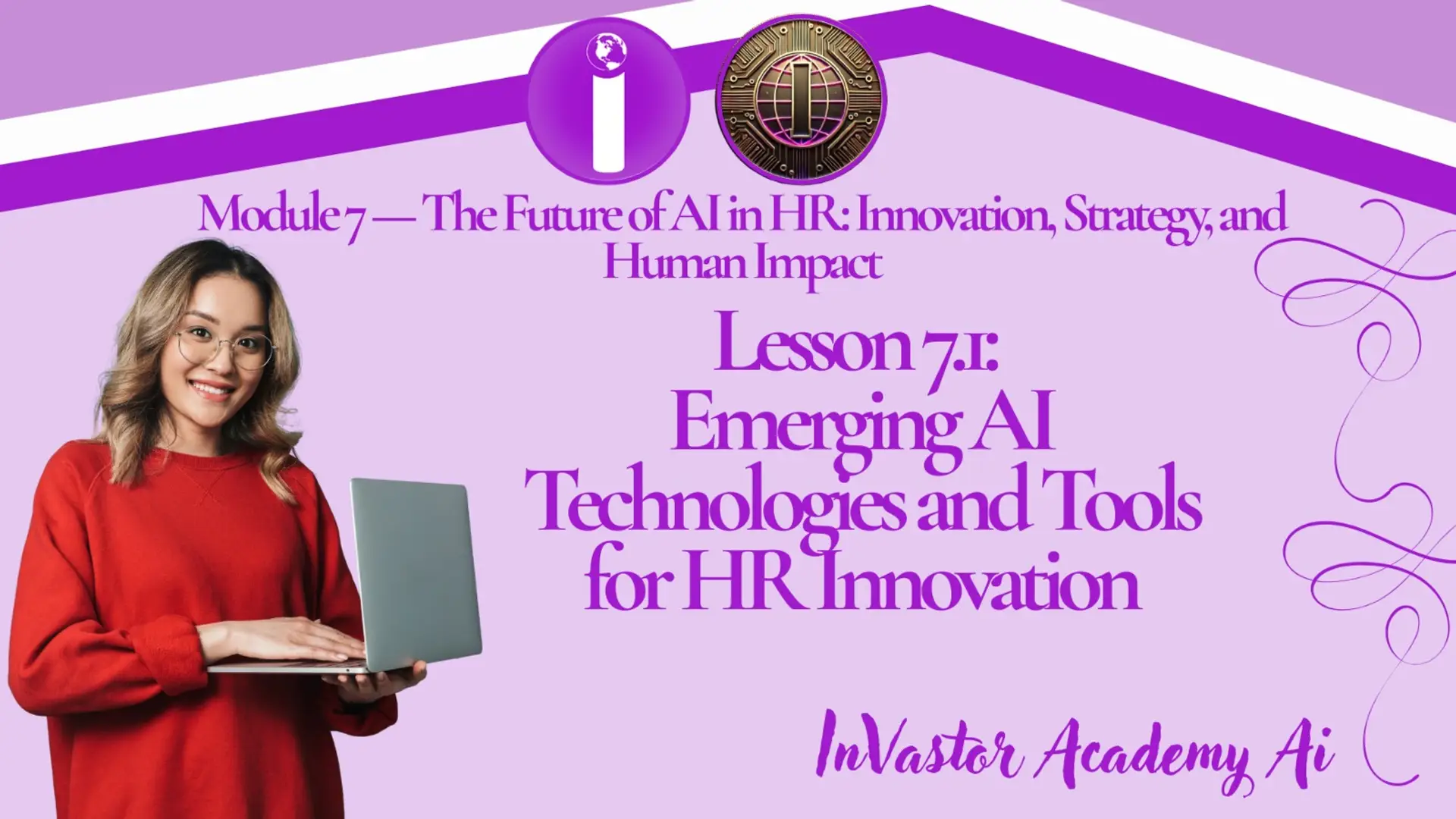

Lesson 7.1 — Emerging AI Technologies and Tools for HR Innovation
Module 7 — The Future of AI in HR: Innovation, Strategy, and Human Impact
Lesson 7.1 — Emerging AI Technologies and Tools for HR Innovation
Learning Objectives
By the end of this lesson, learners will be able to:
- Identify emerging AI technologies transforming HR operations.
- Understand how AI tools are applied across recruitment, learning, performance, and engagement.
- Evaluate the benefits and limitations of different AI solutions in HR.
- Explore real-world examples of AI-enabled HR innovation.
- Assess how new technologies can improve decision-making and employee experiences.
1️⃣ Introduction: The AI Revolution in HR
AI is rapidly shifting HR from a transactional function to a strategic partner.
Emerging technologies enable HR teams to make faster, data-driven decisions, automate repetitive tasks, and personalize employee experiences at scale.
Example:
AI-powered chatbots now handle candidate queries, freeing HR teams to focus on strategic talent planning and employee engagement.
2️⃣ Key Emerging AI Technologies in HR
Technology Description HR Application Example
Machine Learning (ML) Algorithms learn patterns from HR data to make predictions Predicting turnover risk, talent needs, or performance Workday Predictive Analytics
Natural Language Processing (NLP) Understands and interprets human language Resume parsing, sentiment analysis, employee surveys Textio for optimized job postings
Robotic Process Automation (RPA) Automates repetitive HR tasks Payroll, onboarding paperwork, benefits administration UiPath RPA in HR onboarding
Chatbots & Virtual Assistants AI-powered conversational agents Candidate engagement, employee support, FAQs Mya or Olivia AI for recruitment
Computer Vision Analyzes visual data for insights Video interview analysis, office safety monitoring HireVue AI video assessments
Predictive Analytics Forecasts trends and outcomes using data Talent forecasting, succession planning, performance trends Eightfold.ai for internal mobility
AI-Driven Learning Platforms Personalized learning experiences Tailored development plans, upskilling recommendations BetterUp, Coursera for Business
Emotion & Sentiment Analysis Measures employee feelings via text or voice Engagement tracking, well-being monitoring Qualtrics Employee Experience Platform
💡 Insight: These tools allow HR to become proactive rather than reactive, predicting trends and addressing issues before they escalate.
3️⃣ Benefits of Emerging AI in HR
- ✅ Efficiency: Automates repetitive tasks, reducing administrative workload.
- ✅ Enhanced Decision-Making: Data-driven insights improve recruitment, retention, and development.
- ✅ Personalization: Tailors learning, career paths, and engagement strategies.
- ✅ Predictive Insights: Identifies trends like turnover risk or leadership potential.
- ✅ Employee Experience: Improves responsiveness and accessibility via AI-enabled tools.
Example:
Textio uses AI to optimize job postings, ensuring they are inclusive and appealing to diverse talent pools.
4️⃣ Limitations and Considerations
While AI offers significant advantages, organizations must recognize potential challenges:
Limitation Description Mitigation
Bias in AI Models Historical HR data can propagate discrimination Regular bias audits, diverse data inputs
Lack of Explainability Some AI decisions are “black-box” Use explainable AI and document algorithms
Privacy Concerns Sensitive employee data must be protected Encryption, consent, and strict access controls
Over-Reliance on Automation Human judgment may be undervalued Keep humans in the loop for critical decisions
Implementation Costs AI systems can require significant investment Start with pilot projects and scalable solutions
💡 Tip: AI should augment human capability, not replace it.
5️⃣ Real-World Applications and Examples
- Recruitment: Eightfold.ai predicts candidate success and internal mobility opportunities.
- Learning & Development: BetterUp AI suggests personalized coaching and growth pathways.
- Performance Management: Workday’s AI analyzes employee performance trends to inform promotions and training.
- Engagement & Well-Being: Qualtrics uses sentiment analysis to track employee satisfaction and identify risks.
- Career Pathing: Gloat leverages AI to match employees with internal projects for skill growth.
Example:
PepsiCo integrates AI analytics in talent development to forecast leadership gaps and recommend development programs proactively.
6️⃣ Practical Activity
Task:
Select an HR function in your organization (recruitment, learning, performance, or engagement).
- Identify at least two AI tools or technologies that could enhance this function.
- Describe how each tool would improve efficiency, decision-making, or employee experience.
- List potential risks and mitigation strategies.
7️⃣ Supplementary Resources
- 🎥 “The Future of AI in HR Technology” — SHRM Learning Series
- 🎥 “Emerging AI Tools for Recruitment and Talent Management” — Deloitte Insights
- 🎥 “AI in Learning and Development” — Harvard Business Review
- 🎥 “How AI Improves Employee Experience” — McKinsey & Company
Lesson Quiz 7.1
Please complete this quiz to check your understanding of the lesson. You must score at least 70% to pass this lesson quiz. This quiz counts toward your final certification progress.
Answer the quiz using the Google Form below.
Click here for Quiz 7.1
Conclusion
Emerging AI technologies are redefining the HR function — from automating administrative tasks to enhancing strategic decision-making and employee experiences.
By understanding the capabilities, limitations, and ethical considerations of AI tools, HR professionals can lead innovation while safeguarding human impact.
💡 “AI in HR is not just a tool — it’s a strategic partner for shaping the future of work.”
📘 Next Lesson: Lesson 7.2 — Strategic Workforce Planning with AI
📘 Previous Module: Module 7 — The Future of AI in HR: Innovation, Strategy, and Human Impact
📘 Course Outline: Module 7 — The Future of AI in HR
Related Posts
© 2025 Invastor. All Rights Reserved

User Comments